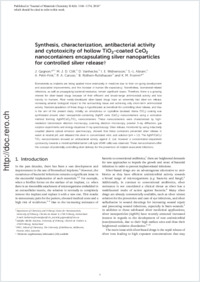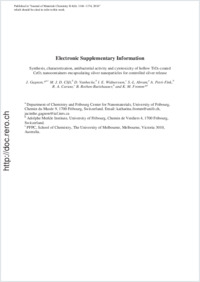Synthesis, characterization, antibacterial activity and cytotoxicity of hollow /TiO₂-coated CeO₂ nanocontainers encapsulating silver nanoparticles for controlled silver release
- Gagnon, Jacinthe Department of Chemistry and Fribourg Center for Nanomaterials, University of Fribourg, Switzerland - PFPC, School of Chemistry, The University of Melbourne, Australia
- Clift, Martin J. D. Adolphe Merkle Institute, University of Fribourg, Switzerland
- Vanhecke, Dimitri Adolphe Merkle Institute, University of Fribourg, Switzerland
- Widnersson, I. E. PFPC, School of Chemistry, The University of Melbourne, Australia
- Abram, Sarah-Luise Department of Chemistry and Fribourg Center for Nanomaterials, University of Fribourg, Switzerland
- Petri-Fink, Alke Adolphe Merkle Institute, University of Fribourg, Switzerland
- Caruso, R. A. PFPC, School of Chemistry, The University of Melbourne, Australia
- Rothen-Rutishauser, Barbara Adolphe Merkle Institute, University of Fribourg, Switzerland
- Fromm, Katharina M. Department of Chemistry and Fribourg Center for Nanomaterials, University of Fribourg, Switzerland
-
02.02.2016
Published in:
- Journal of Materials Chemistry B. - 2016, vol. 4, no. 6, p. 1166–1174
English
Biomaterials as implants are being applied more extensively in medicine due to their on-going development and associated improvements, and the increase in human life expectancy. Nonetheless, biomaterial-related infections, as well as propagating bacterial resistance, remain significant issues. Therefore, there is a growing interest for silver-based drugs because of their efficient and broad-range antimicrobial activity and low toxicity to humans. Most newly-developed silver-based drugs have an extremely fast silver-ion release, increasing adverse biological impact to the surrounding tissue and achieving only short-term antimicrobial activity. Nanoencapsulation of these drugs is hypothesized as beneficial for controlling silver release, and thus is the aim of the present study. Initially, an amorphous or crystalline (anatase) titania (TiO₂) coating was synthesized around silver nanoparticle-containing (AgNP) ceria (CeO₂) nanocontainers using a sonication method forming AgNP/CeO₂/TiO₂ nanocontainers. These nanocontainers were characterized by high-resolution transmission electron microscopy, scanning electron microscopy, powder X-ray diffraction, gas sorption experiments and energy-dispersive X-ray spectroscopy. Silver release, monitored by using inductively coupled plasma optical emission spectroscopy, showed that these containers prevented silver release in water at neutral pH, and released the silver in concentrated nitric acid solution (pH = 1.1). The AgNP/CeO₂/TiO₂ nanocontainers showed an antibacterial activity against E. coli, however a concentration-dependent cytotoxicity towards a model epithelial barrier cell type (A549 cells) was observed. These nanocontainers offer the concept of potentially controlling silver delivery for the prevention of implant-associated infections.
- Faculty
- Faculté des sciences et de médecine
- Department
- Département de Chimie
- Language
-
- English
- Classification
- Chemistry
- License
- License undefined
- Identifiers
-
- RERO DOC 258829
- DOI 10.1039/C5TB01917F
- Persistent URL
- https://folia.unifr.ch/unifr/documents/304937
Other files
Statistics
Document views: 52
File downloads:
- fro_sca.pdf: 119
- fro_sca_sm.pdf: 77

